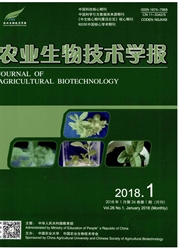

 中文摘要:
中文摘要:
低氧是水产养殖动物面临的主要胁迫之一。鳙(Hypophthalmichthys nobilis)是我国最重要的淡水养殖鱼类之一,其对低氧胁迫敏感,但相关的遗传基础研究报道很少。本研究利用cDNA.扩增片段长度多态性(cDNA—amplified fragment length polymorphism,cDNA—AFLP)技术对低氧敏感和低氧耐受两组鱼进行比较分析,鉴定鳙与低氧反应相关的信号通路中的差异表达基因。从EcoRI和MseIAFLP体系的256个引物组合共获得10571条转录衍生片段(transcript-derived fragments,TDFs)。其中,低氧胁迫后差异表达的TDFs数目为221个,包括上调表达137个(62%),下调表达84个(38%)。对70个差异TDFs成功地进行了切胶回收、PCR产物克隆和测序,序列比对分析后发现:29个TDFs在数据库中未检索到同源序列;9个TDFs比对到未知功能序列;32个TDFs比对到已知生物学功能的序列,其功能包括转录调控、应激和信号转导、能量代谢、蛋白质合成、免疫防御以及细胞生长与增殖。随机选取4个己知功能的TDFs(ANXA6、TRIM25、Tnp和RBAn进行qRT-PCR验证,结果显示:ANXA6、TRIM25和Tnp在低氧胁迫后的表达模式与AFLP分析结果一致,RBAT与AFLP结果不一致。本研究结果有助于揭示鳙应对低氧逆境的生理和遗传调控机制,同时对鳙抗逆品种的分子标记辅助选育也有一定的参考价值。
 英文摘要:
英文摘要:
Hypoxia is one of the major stresses nobilis) is one of the most important aquaculture in aquaculture animals. Bighead carp (Hypophthalmichthys fish in China, which is sensitive to hypoxia stress, and the related genetic research is rarely reported. In this study, six hypoxia-sensitive samples (S group) and six hoypoxia-tolerant samples (T group) from a hypoxia stress experiment of bighead carp were selected, and differentially expressed genes between the two groups were analyzed using cDNA-amplified fragment length polymorphism (cDNA-AFLP) technique. A total of 10 571 transcript-derived fragments (TDFs) were obtained from 256 primer combinations of the EcoR I and Mse I AFLP system, and the number of TDFs produced by a single primer combination ranged from 21 to 63, with an average of 41. Four types of differential straps were screened in the hypoxia stress experiment of bighead carp, including A (up-regulated band), B (downregulated band), C (the fragment only expressed in one sample) and D (the fragment expressed in all samples), and bands of types A and B were chosen as target bands. Among those 221 differentially expressed TDFs between two groups, 137 (62%) were up-regulated, and 84 (38%) were down-regulated. 70 TDFs were successfully cloned and sequenced, and the length of fragments ranged from 96 to 402 bp. The results of sequence blast against public databases revealed that 29 TDFs (TDF42-TDF70) had no hits to any known homologous sequences, 9 TDFs (TDF33-TDF41) were unknown functional sequences, and 32 TDFs (TDF1-TDF32) showed homology to genes of known functions. Among the 32 differentially expressed TDFs, TDF29 and TDF32 sequences were different but both encoded the same protein (S- adenosylmethionine synthase). These functional genes participated in such physiological pathways as transcriptional regulation (16%), stress and signal transduction (9%), energy metabolism (7%), protein synthesis (4%), immune defense (4%) and cel
 同期刊论文项目
同期刊论文项目
 同项目期刊论文
同项目期刊论文
 期刊信息
期刊信息
